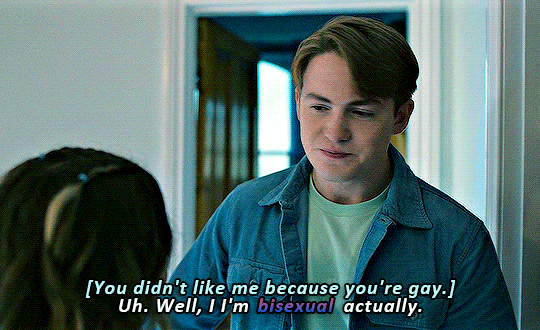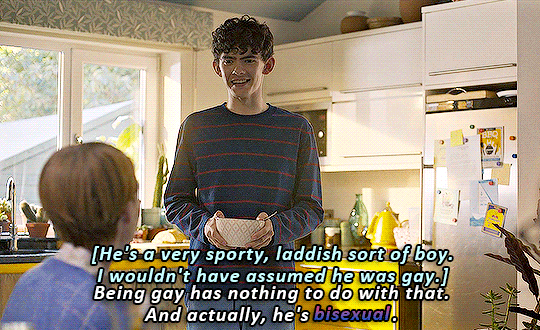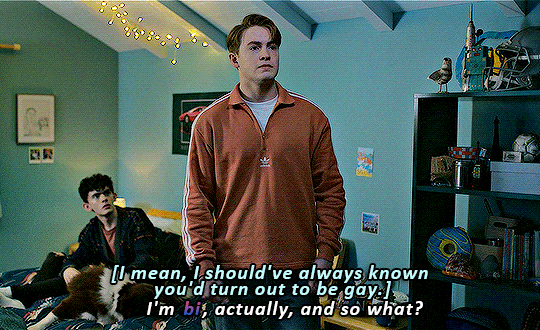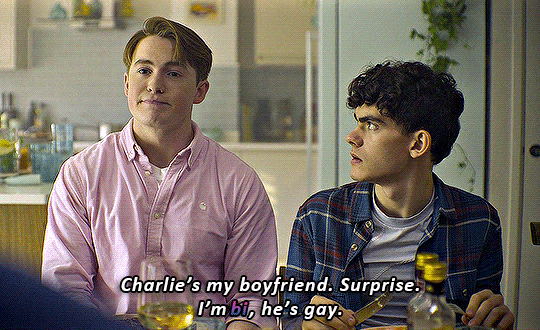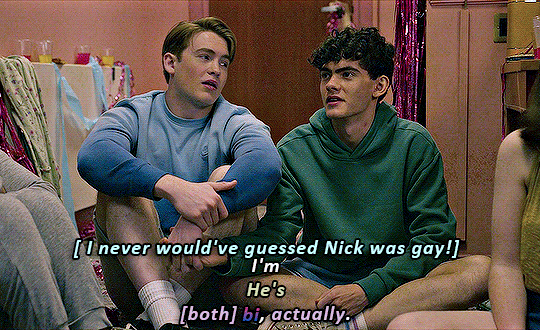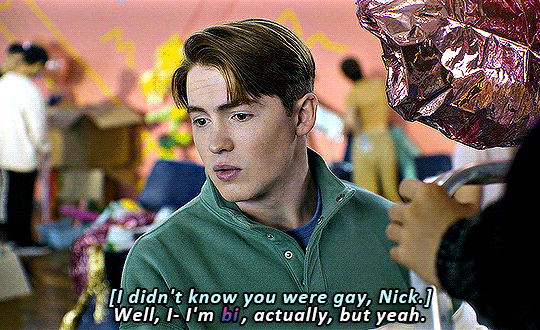mid thirties bi guy reading books from libraries on the east coast (likely sff/ya, but mainly m/m smut of late)
Don't wanna be here? Send us removal request.
Text
The Children of Harvey Milk - Andrew Reynolds

Simon Hughes is one of only six men who have been elected to national office to identify as bisexual; as of January 2018 there have been eight women, elected in seven wealthy Western countries. That's fourteen total over time (only 3% of the total of all LGBT representatives) and five currently in office (again 3% of the total). There are only two out bisexual men in office anywhere in the world today (Sweden and Britain), both Conservatives. In the United States there is (and has only ever been) a single out self-identifying bisexual congressperson, Kyrsten Sinema, and a lone governor, Kate Brown of Oregon. There have been eleven bisexual US state legislators in history, but only five in office as of 2017. This consistent share of the LGBT cohort—a tiny number— sits jarringly with the fact that the majority of LGBTQ people today (where we have good data) identify as bisexual. In 2011 Gary Gates at the Williams Institute found that over half of LGB Americans self-identified as bisexual (52%). Gay men accounted for 31 percent and lesbians for 17 percent. Indeed, the largest individual group within the umbrella were women who identified as bisexual (33%), and bisexual men (19%) outnumbered lesbians.
1 note
·
View note
Text

Bi Men by Women, Chapter 2
This is a really dense chapter covering theories, definitions, and literature overview. I don’t care much about the theories of social processes (“border women and their border men”), but some good quotes are below.
Quote: The queer spouse's same-sex desire has to mean that he loves his wife less than he (and she) thought he did; his acting on that desire has to be a move away from the marriage. Conversely, his love for his wife and commitment to the marriage have to be a force that undermines the importance and validity of his same-sex desire. (Swan and Benack 2012)
In research, bisexual men remain underresearched. Even a basic “how many?” is hard to answer because it varies depending on whether the research uses identity or behavior as the defining criteria. Male bisexuality usually appears in only three research contexts: medical, sexual, and denial.
Statistics:
- 33% of the bisexual sample in Page (2004) was involved in a polyamorous relationship; 54% considered this type of relationship ideal.
- Of the 90 straight women married to gay/bi men in Pearcey and Olson (2009), 46% had divorced while 17% remained married.
- Elder and Shea (2002) studied bi men in monogamous marriages. They were all still attracted to males; the majority of them married for love and still loved their wives. 80% disclosed to their wives to some degree. Their marriages are not brief: 45% at 5-9 years of marriage, 10% at 10-19 years, 25% at 20+ years. Bisexual married men =/= inevitable divorce.
Also, it turns out researchers really like to classify bisexuality.
- Six patterns of bisexuality: (1) transitional as part of the process of coming out as gay (2) almost exclusively homosexual/heterosexual with occasional deviations (3) serial/alternating patterns of exclusive homo- and heterosexuality (4) predominantly heterosexual with some homosexual contacts (5) predominantly homosexual with some heterosexual contacts (6) large numbers of homo and heterosexual contacts. [Boulton et al 1989]
- Nine different types of bisexuality: (1) situational bi—eg. in prison (2) transitional bi—see above (3) chic bi—swingers or girls pleasing a boyfriend. (4) historic bi (5) technical bi (6) cop-out bi (7) sequential bi (8) concurrent bi (9) experimental bi. [Meyer 2010]
- Malcolm 2000: adventurers (opportunistic homosexuals), avoiders, repressors, defensives.
Many more pages of these, but honestly I felt that none of these categories really fit me so ¯\_(ツ)_/¯
#lgbtq#bi men by women#maria pallotta chiarolli#bisexuality#bisexual men#bi men#women in relationships with bisexual men
2 notes
·
View notes
Text
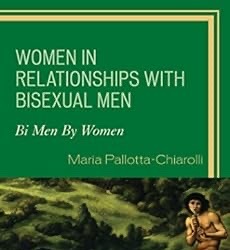
Bi Men by Women; Women in Relationships with Bisexual Men — Maria Palotta-Chiarolli
I started reading this a couple months ago after ordering this book-after seeing this book in the references of either Vaneet Mehta’s Bisexual Men Exists or Julia Shaw’s Bi and I-just-gotta-have-this-book.
But now it’s been several months and I’m only halfway. The problem is: this book is very academic. With my partner we recently read Boyslut by Zachary Zane and it reads very easily. This.. is not that.
This book is still a treasure though, and I thought one thing that would be interesting (to me at least) is to copy the summary of each chapter and note how the themes in this book resonate/not with my experiences and relationship, being a bisexual man in a marriage to a straight woman.
Here’s how Palotta-Chiarolli organized this 541-page book:
Introduction
Theories and debates
Women talk about their partners’ bisexualities (“you know, the old Kinsey scale”)
The women’s sexualities (“I have a sexuality too”)
Negotiating the beginning of the relationship
From closet to confrontation; changing course midstream
Staying the course or splitting up?
Rules in relationships
Masculinity, misogyny, privilege, and power: (“the problem is that he’s a man, not that he’s bisexual”)
“What do we tell the kids?”
Spreading disease
Navigating the heteroworld
Homonormativity
“The priest told him to marry me and he’d go straight.”
Family honor and shame
Erasures in health services
Final words
We’ll just start with chapter 1 below the fold, and I’ll make a separate post for each chapter as I go (I’m only on chapter 7 so far).
MPC interviewed 78 Australian women. Age range:19-65. Mostly the research relies on women who came forward and responded to recruitment flyers and emails to various support groups plus snowball sampling.
Of the women/couples: 30 are in Sydney/NSW, 28 in Melbourne/Victoria, 8 in Adelaide, the rest are scattered. Most of the women and their partners are of European descents (Anglo-Australian), with a minority of Pakeha NZ (4 men and 2 women), mixed Chinese (2 women), one of each: Egyptian, Ghanaian, indigenous, and Chinese.
Roughly half are atheist/agnostic/unspecified religion which includes Wicca and pagan, the other half are mainly various flavors of Christianity (catholic Protestant anglicans), and two Muslim converts (both Anglo-Australians).
24 couples are married. About the same number divorced/separated from their partner. The rest are de-facto together but not married. The married couples have been married for a long time: 2/3 of them 15 years of longer. The separated/divorced ones separate after being together/married for fifteen years! A lot of them have children, only a minority did not: 15 couples. Not all of the men identify as bisexual, 14 of them are tabulated as Gay. (And of the 14, 10 of them are now separated or divorced).
Why this book? MPC: women and their bi male partners are subjected to underrepresentation/erasure, misrepresentation/biphobia/bi-negativity, outdated representation, homogenized representation.
Quotes:
Steinman (2011) found that bisexual men were less likely than bisexual women to publicly and analytically articulate their experiences.
#bi men#bi men by women#women in relationships with bisexual men#Maria pallotta-chiarolli#bisexual men#bisexuality#lgbt#lgbtq#lgbtqia
2 notes
·
View notes
Text
Everything is Beautiful And I’m Not Afraid: A Baopu Collection by Yao Xiao

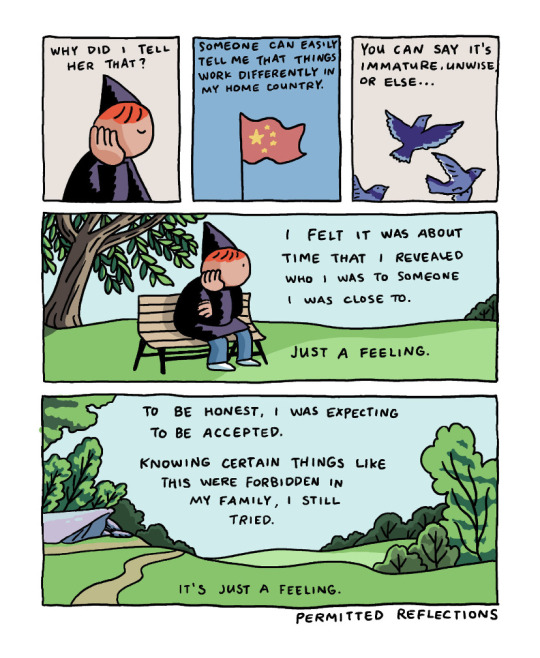
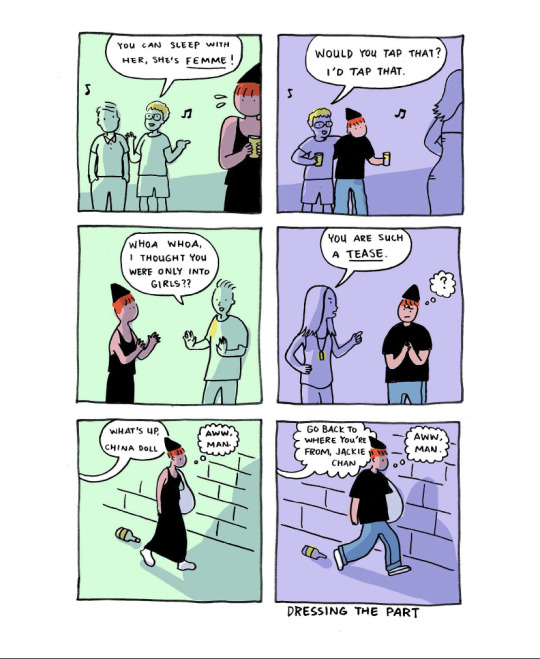
0 notes
Text
Roughly six months ago I picked up KJ Charles’s The Magpie Lord (probably after stumbling upon @fahye’s recommendations) and I’ve been on a binge ever since.
Well tonight I finished reading her entire back catalogue. Forty-something books and novellas and short stories. The Charm of Magpies, Society of Gentlemen, Sins of the Cities, Lilywhite Boys, Will Darling, Green Men, Gentle Art, Doomsday, and all the standalone books.
What’s really interesting to me is that a lot of her books are trilogies, but I often end up liking the second books in the trilogies the best. That rarely happens with trilogies for me, but she has managed to strike the balance between going back/expanding a familiar setting from the first book, but ratcheting up the ante enough to make them truly gripping.
I also like the plots-mysteries-whodunnits too. I never felt the romance to be too saccharine because typically I’ll be engrossed in the mystery. Even when the premise are quite dumb (I’m looking at you, Gilded Cage)—by the end of the book I’d be hooked.
I also felt her representations were done quite well. There are several Black (main) characters throughout her work, and people from Indian heritage. I don’t care much for Clem Talleyfer (half Indian, a bastard son) in An Unseen Attraction but I really like Vikram and Gil’s dynamic in Unfit to Print. Vikram wasn’t white but he’s dripping privilege.. while Gil had to scrabble a living—in KJ Charles’s word: being a bookseller of ill repute. One of the last books that I read was An Unsuitable Heir, and the non-binary character (and the pairing with a one-armed man) made me think about my non binary friend from real life.
Honestly, I’m just in awe. I am thoroughly entertained, and I even get to infect my partner to read her too. (It’s been fun. I think it’s a tossup between Will Darling and Gilded Cage as our favorite.)
#kj charles#gilded cage#lilywhite boys#an unseen attraction#sins of the cities#an unsuitable heir#unfit to print#will darling adventures#charm of magpies
20 notes
·
View notes
Text

Ohh this anthology just sings to my heart. And I really didn’t expect this, not being an Arab myself. Also I had just read a couple of good books when I picked it up so surely the law of averages would work against it. Plus with virtually any anthology, the level of quality typically varies wildly from one entry to another.
But the first essay was a really strong essay by Mona Eltahawy. “I am writing this almost exactly ten years after I died. The Mona I used to be died on 24 November 2011, on a street called Mohamed Mahmoud, near Tahrir Square, Cairo.” She wrote of coming into an understanding of herself, and much of it resonated with me. “When Y and I had penis-to-vagina sex I stopped reading the Quran. I could not stand reading the word ‘fornicators’ repeated again and again.” She wove her personal experiences with her reading of Adrienne Rich, Ursula Halligan, Bareed Mista3jil—an edited volume of women experiences in Lebanon, and June Jordan. She quoted Jordan, “Bisexuality means I am free.”
She admitted to a man in a queer club in Bosnia in 2016 that she too, is a bisexual. This after in 2013 her not using any label and did not explore her attraction to women, and in 2015 email exchange not ready to say that she is not only polyamorous but also bisexual. I felt triumphant reading her progression and my heart warmed so much.
This was followed by Salem Haddad, writing about his return to Beirut. When he learned of the explosion he was at the gym in Lisbon. “I stood in the center of the gym for a long time, examining the photos and sending messages to friends. Around me, the world continued as normal. The gym attendant scolded me for not wiping the kettlebell after I used it. It was impossible to grieve from afar.” When he got to Beirut, he hooked up with a lover. “I am reminded of why I have spent eighteen months pining for him, why I wrote and published an entire story inspired by him: because something about him — his eyes, his smile, his calves — reminds me of home, my childhood, Mediterranean beaches and hot, humid summers.”
“In this moment though I feel estranged from so many things, I feel at home in my desire; it is a return of sorts, to live in the moment, to bring the encounter to the light, devoid of shame. It is a sort of homecoming, a return to oneself.”
I can go on for nearly each and every essay. Dima Mikhayel Marta’s story of his father (‘promises to cumin are not kept’), Amrou Al-Kadhi’ clash with their mother.
Danny Ramadan’s essay paved the path for what is the most resonant essay in the collection for me: Anbara Salam’s Unheld Conversations. Ramadan: “There is a tendency among the audiences of marginalized authors to assume that every piece of writing is a reflection of real-life events that the author went through.”
Salam: “just before my second novel, Belladonna, was published, I have each of my parents an advance proof copy. They had both read my first book. But unlike my first novel, Belladonna is written in the first person, and the narrator is a queer Arab woman.
And so, as I handed over the soon-to-be-published book to my parents, it was with a certain anticipation, maybe trepidation. I left them to read the novel and waited for the conversation about my sexuality that we had always avoided. Both of my parents read the book. We never had a conversation. The special flavour of disappointment I felt is hard to express. Yes, the terror of facing this confrontation had been removed, but I’d prepared, I was ready. The fight music was playing but the match was called off, and I had to walk away.”
I’ve now used Salam’s essay as a crutch to understand and interpret my own experiences coming out to others and a public coming out of a sort that were followed with its own Unheld Conversations, which brings its identical disappointment.
This was an amazing collection, well worth the read. Maybe I needn’t be surprised that the essays were really really good, most of the contributors are themselves writers with accolades aplenty. 5/5 stars, instant recommendations.
#this Arab is queer#mona eltahawy#Danny Ramadan#anbara salam#saleem haddad#Elias jahshan#Dima mikhayel matta#lgbtq anthology#bisexual#lgbtq
1 note
·
View note
Text
Bisexual Men Exist — Vaneet Mehta
Like another reviewer on Goodreads, I too wasn’t sure what I’d get from this book. If the main message is the title—bisexual men exist—then the cover page has made the proclamation clear so what’s in the rest of the book? (Also, I exist, don’t I? QED? what more do I need?)
Still, it’s an important message because it’s (/we are) too often ignored, dismissed, or overlooked.
I started reading the book anyway, though, learned a new-to-me term in the first couple of pages (m-spec: multi-gender attraction), and found myself devouring half the book in one sitting. This is a very readable book. Vaneet Mehta did a really good job in writing it.
Partly I think it’s because he’s starting with the familiars: the few representations in TVs (and missed opportunities). (Although there’s no mention of Nick Nelson’s character from Alice Oseman’s Heartstopper or the forced outing of Kit Connor, but the Netflix series is maybe too recent to have made the cut.)
The book cites some statistics, weaved together with narratives from Vaneet’s contributors. These contributors are integrated into the narrative with very little introduction: just their names, mostly. In various sections we get slightly more details (eg., what culture they come from in the section about intersectionality, or their degrees in a section about accessing mental health, but little more). These mostly work, although there were a couple of places where I noticed I was a little confused. At the end of the book there’s a complete list of names (several dozens of them) and pronouns but that’s it.
I came out of reading this book finding out more materials to read. The Bi-ble: New Testimonials (eds: Lauren Nickodemus); Women in Relationships with Bisexual Men: Bi Men by Women (Maria Pallotta-Chiarolli); Bi-America: Myths, Truths and Struggles of an Invisible Community (William Burleson).
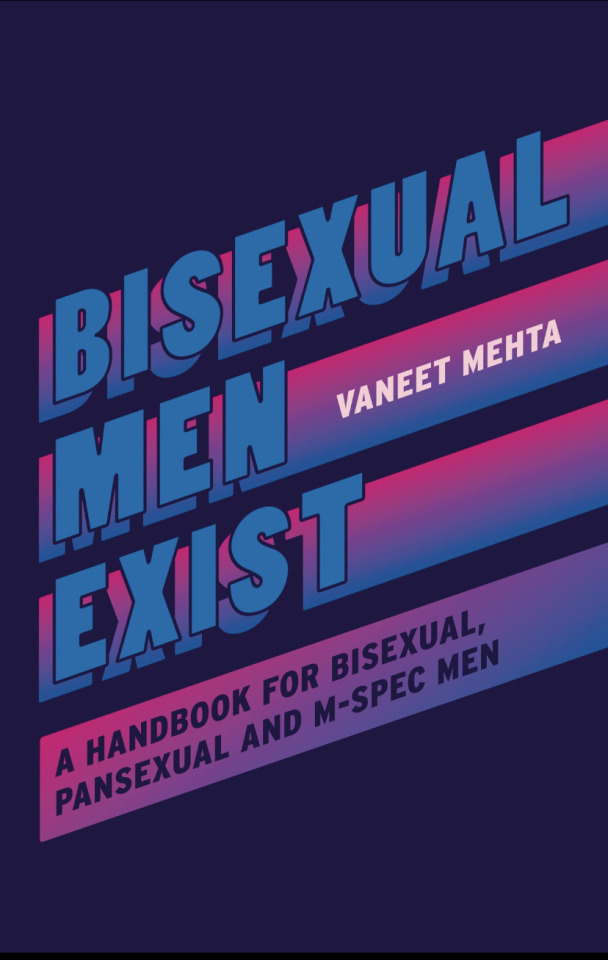
0 notes
Text

The Outlaws Scarlett and Browne - Jonathan Stroud
I read this after rereading Lockwood and Co. and The Amulet of Samarkand, thinking l'm gonna check out Stroud's new book.
It feels different: unlike in the Bartimaeus trilogy where magicians rely on daemons from the Other Place, or Lockwood where children have perception talents to fight ghosts (which come from an Other Place too), here powers seem to be innate to some individuals in a way that marks the individuals a la X-Men or The Chrysalids. The Chrysalids might be the closest thing I've read prior to this and really I read that because Noah Reid narrated it.
Anyway, Chrysalids: some individuals are born "deviant" from the standard, and in Browne's case he became a subject of experimentation. He can move objects with his thoughts, read other people's thoughts (reminiscent of the telepathy in Chrysalids), and in distress his body is taken over by The Fear (as yet unspecified). There's also a strong use of religiosity, Scarlett seems to do a blend of Buddhism and Islam with her semi-regular prayer on a prayer mat (which she has used at some point to clobber another person). While Chrysalids is very agricultural, this is a Wild West western, set in a post-apocalyptic London: the City submerged in the Thames and new kingdoms arose in the British island (Chrysalids were... Canada?). I don't know if the lack of humor here compared to Lockwood or Bartimaeus is due to the setting being more bleak than alt-London or else, but in this way this makes it feel different than the two series.
5 notes
·
View notes
Text
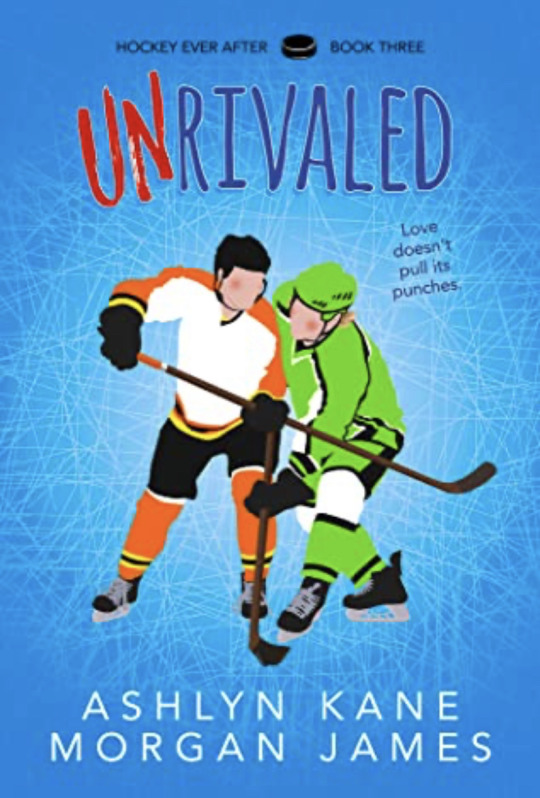
Unrivaled - Ashlyn Kane & Morgan James (Hockey Ever After #3)
Read March 2023, after finishing Scoring Position, the second book in the series. M/M.
Unrivaled follows Max Lockhart and Grady Armstrong, hockey players for fictitious NHL teams NJ Monsters and Philly Firebirds (later Piranha and Condors). They are rivals—Max is particularly successful in goading Grady on the ice, costing Grady awards in fair play. Rivalries led to a Grindr hookup led to fake dates led to feelings™️ to working on a relationship.
This is a cozy read (🌶️) and not much angst. Grady thought Max spilled their hookup to his teammate which led to Grady blocking Max’s text messages and Max blocking Grady on Instagram. One of their teams was eliminated earlier in contention of the Stanley Cup and they had to navigate dealing with their team losing in the league. Cameos from earlier characters in the series, particularly Dante Baltierra/Baller from book one and passing mentions of Nico Kirschbaum from book two.
A Goodreads reviewer for book two mentions how she didn’t like that the NHL teams were fictitious because why would she root for a losing fictitious team but because I know zilch about pro hockey it makes no difference to me. Now that this is my sixth? seventh? m/m hockey book that I read I am starting to see how mid-season trades are used for plot points (sounds exhausting and players are expected to uproot their entire lives to a wholly new team in a different city at mere moments’ notice?). If I actually cared about hockey leagues the Stanley Cup thing would’ve upped the ante for me but because I don’t, I get it’s an important thing but had no particular significance for me. In one of the fake dates they went to an American Ninja Warrior gym and I thought it’s interesting that the authors went to describe the details at length and I wonder how well it will age if/when ANW fell out of popularity. Matching tattoos: a 🦞 and a lobster cracker.
Rep: Dante is bisexual. Max also says he is bisexual. Grady’s sister Jess is a lesbian, also a pro hockey player, entangled in an f/f/f situation.
#hockey ever after#Ashlyn Kane#Morgan James#unrivaled#Max Lockhart#Grady Armstrong#m/m books#m/m hockey#bisexual men rep
4 notes
·
View notes
